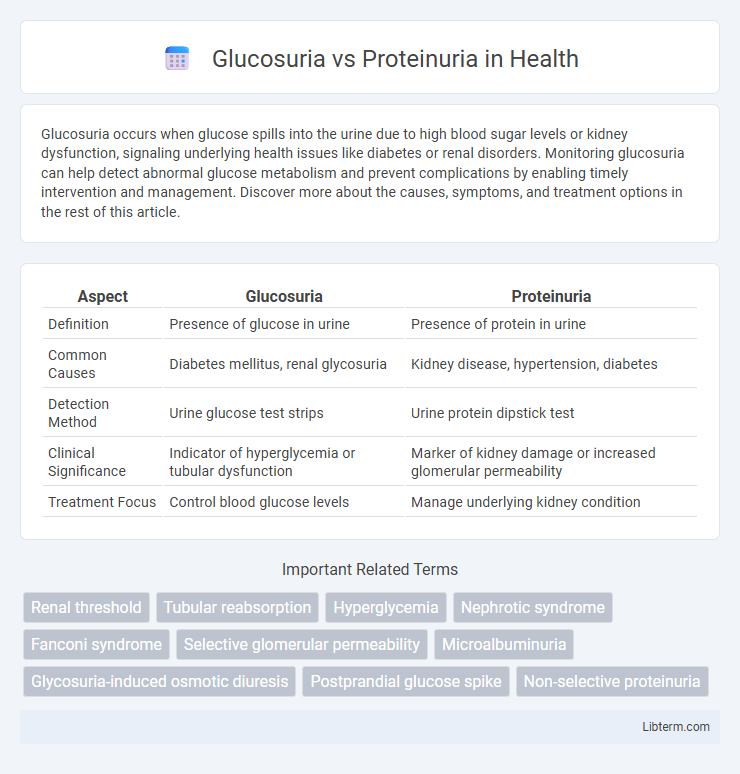Glucosuria occurs when glucose spills into the urine due to high blood sugar levels or kidney dysfunction, signaling underlying health issues like diabetes or renal disorders. Monitoring glucosuria can help detect abnormal glucose metabolism and prevent complications by enabling timely intervention and management. Discover more about the causes, symptoms, and treatment options in the rest of this article.
Table of Comparison
| Aspect | Glucosuria | Proteinuria |
|---|---|---|
| Definition | Presence of glucose in urine | Presence of protein in urine |
| Common Causes | Diabetes mellitus, renal glycosuria | Kidney disease, hypertension, diabetes |
| Detection Method | Urine glucose test strips | Urine protein dipstick test |
| Clinical Significance | Indicator of hyperglycemia or tubular dysfunction | Marker of kidney damage or increased glomerular permeability |
| Treatment Focus | Control blood glucose levels | Manage underlying kidney condition |
Understanding Glucosuria: Definition and Causes
Glucosuria, the presence of glucose in the urine, occurs when blood glucose levels exceed the renal threshold, commonly due to uncontrolled diabetes mellitus or renal glycosuria. Unlike proteinuria, which indicates kidney damage through abnormal protein excretion, glucosuria primarily signals hyperglycemia or specific renal tubular dysfunction. Understanding glucosuria involves recognizing its association with conditions such as diabetes, hormonal imbalances, and certain medications affecting glucose reabsorption in the kidneys.
Proteinuria Explained: An Overview
Proteinuria refers to the abnormal presence of excess protein in the urine, often signaling kidney damage or disease such as glomerulonephritis or nephrotic syndrome. Unlike glucosuria, the presence of glucose in the urine primarily indicates uncontrolled diabetes mellitus or renal glycosuria. Detecting proteinuria through urine tests like the spot urine protein-to-creatinine ratio is crucial for early diagnosis and management of chronic kidney disease and other renal pathologies.
Key Differences Between Glucosuria and Proteinuria
Glucosuria is characterized by the presence of glucose in the urine, often indicating hyperglycemia or diabetes mellitus, while proteinuria involves abnormal amounts of protein, primarily albumin, in the urine, signaling kidney damage or filtration issues. Unlike glucosuria, which typically arises from excess blood glucose exceeding renal threshold, proteinuria reflects increased glomerular permeability or tubular dysfunction. Diagnostic tests differentiate these conditions: urine glucose test for glucosuria and urine protein or albumin-to-creatinine ratio for proteinuria, guiding distinct clinical management strategies.
Underlying Mechanisms of Glucosuria
Glucosuria occurs when the renal tubular maximum glucose reabsorption capacity is exceeded due to hyperglycemia, leading to glucose leakage into the urine; this often results from uncontrolled diabetes mellitus or renal tubular dysfunction. The underlying mechanism involves impaired function of sodium-glucose co-transporters (SGLT2) in the proximal tubules, which are responsible for reabsorbing filtered glucose. In contrast, proteinuria primarily arises from glomerular damage causing increased permeability to plasma proteins, highlighting distinct pathophysiological processes between the two conditions.
Pathophysiology of Proteinuria
Proteinuria results from increased glomerular permeability or impaired tubular reabsorption, allowing abnormal amounts of protein to pass into the urine. Damage to the glomerular basement membrane or podocytes disrupts the filtration barrier, promoting protein leakage. Tubular dysfunction may also reduce the reabsorption of filtered proteins, exacerbating proteinuria in kidney diseases.
Common Symptoms: Glucosuria vs Proteinuria
Glucosuria and proteinuria both indicate abnormal substance presence in urine, often reflecting underlying renal or systemic conditions. Common symptoms of glucosuria include frequent urination, excessive thirst, and elevated blood sugar levels, typically associated with diabetes mellitus. Proteinuria frequently presents with swelling in the hands, feet, or face, foamy urine, and signs of kidney dysfunction, often linked to glomerular damage or chronic kidney disease.
Diagnostic Tests for Glucosuria and Proteinuria
Diagnostic tests for glucosuria primarily involve urine glucose dipstick tests that detect glucose concentrations exceeding the renal threshold, often supplemented by blood glucose measurements to assess hyperglycemia. Proteinuria is diagnosed using urine protein dipstick tests, spot urine protein-to-creatinine ratio, or 24-hour urine protein quantification to evaluate the extent and type of protein leakage. Both conditions require confirmatory tests such as blood analysis and renal function tests to determine the underlying systemic or renal pathologies.
Risk Factors and Associated Conditions
Glucosuria often results from uncontrolled diabetes mellitus, where high blood glucose levels exceed renal reabsorption capacity, posing risks such as diabetic nephropathy and ketoacidosis. Proteinuria indicates kidney damage linked to conditions like hypertension, glomerulonephritis, and chronic kidney disease, signaling increased permeability of the glomerular filtration barrier. Both conditions serve as critical biomarkers for systemic diseases requiring targeted management to prevent progression to end-stage renal disease.
Treatment Strategies for Glucosuria and Proteinuria
Treatment strategies for glucosuria primarily focus on controlling underlying diabetes mellitus through lifestyle modifications, including diet and exercise, as well as pharmacologic interventions like insulin or oral hypoglycemic agents. Proteinuria management emphasizes reducing glomerular damage by addressing conditions such as hypertension and chronic kidney disease using angiotensin-converting enzyme (ACE) inhibitors or angiotensin receptor blockers (ARBs). Both conditions require regular monitoring of blood glucose levels and kidney function tests to prevent progression and complications.
Preventive Tips for Maintaining Renal Health
Maintaining renal health involves regular monitoring of blood glucose and urine protein levels to detect early signs of glucosuria and proteinuria, which indicate potential kidney dysfunction. Adopting a balanced diet low in processed sugars and excessive protein intake supports kidney function and helps prevent damage caused by high glucose or protein levels in the urine. Hydration, blood pressure control, and avoiding nephrotoxic substances such as NSAIDs and certain antibiotics are crucial preventive measures to reduce the risk of kidney disease progression.
Glucosuria Infographic

 libterm.com
libterm.com